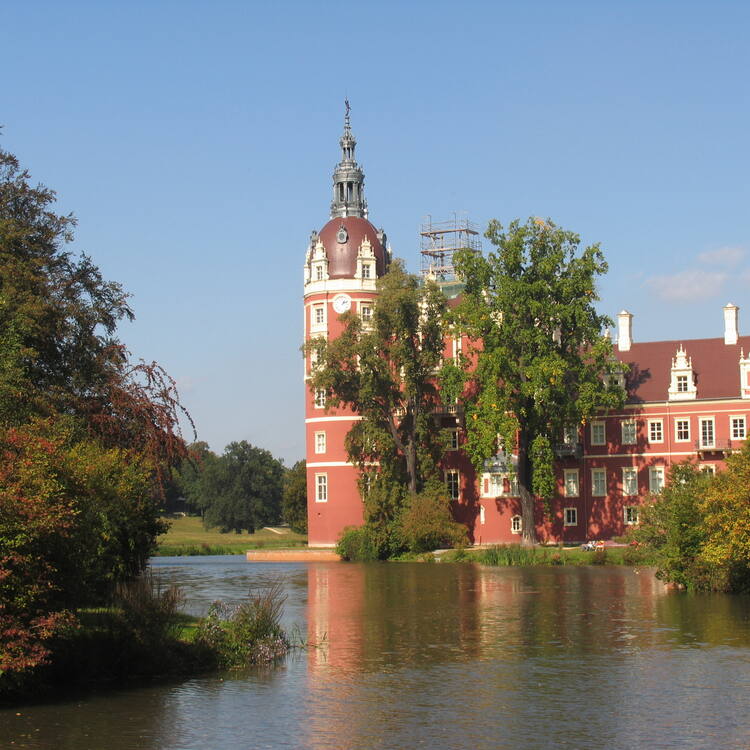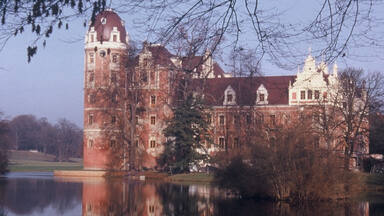Muskauer Park / Park Mużakowski
Muskauer Park / Park Mużakowski
A landscaped park of 559.9 ha astride the Neisse River and the border between Poland and Germany, it was created by Prince Hermann von Puckler-Muskau from 1815 to 1844. Blending seamlessly with the surrounding farmed landscape, the park pioneered new approaches to landscape design and influenced the development of landscape architecture in Europe and America. Designed as a ‘painting with plants’, it did not seek to evoke classical landscapes, paradise, or some lost perfection, instead using local plants to enhance the inherent qualities of the existing landscape. This integrated landscape extends into the town of Muskau with green passages that formed urban parks framing areas for development. The town thus became a design component in a utopian landscape. The site also features a reconstructed castle, bridges and an arboretum.
Description is available under license CC-BY-SA IGO 3.0
Parc de Muskau / Parc Mużakowski
Ce parc paysager de 559,90 ha, situé de part et d’autre de la Neisse et de la frontière germano-polonaise, a été créé par le prince Hermann von Pückler-Muskau entre 1815 et 1844. S’inscrivant harmonieusement dans le paysage agricole environnant, ce parc inaugura de nouvelles conceptions paysagères et influença le développement de l’architecture paysagère en Europe et en Amérique. Conçu comme un « tableau de verdure », il ne cherchait pas à évoquer un paysage classique, une image de l’Éden ou quelque perfection perdue, mais exploitait la flore locale pour exalter les qualités intrinsèques du paysage existant. Ce paysage intégré se prolonge jusqu’à la ville de Muskau, avec des zones de verdure constituant des parcs urbains qui encadraient les zones urbanisées. La ville devenait ainsi une des composantes d’un paysage utopique. Le site comprend également un château reconstruit, des ponts et un arboretum.
Description is available under license CC-BY-SA IGO 3.0
منتزه موسكاو / منتزه موزاكوفسكي
إن هذا المنتزه المدروس الهندسة والذي يمتد على 559,90 هكتارا والواقع على ضفتي النايس والحدود الألمانية البولندية قد نشأ على يد الأمير هرمان فون بوكلر- موسكاو بين العامين 1815 و 1844. وهو يندمج بطريقة انسيابيّة جداً في المنظر الزراعي المحيط، وقد سمح بالاضطلاع بمفاهيم جديدة في هندسة الحدائق وأثر على تطوّر هندسة الحدائق في أوروبا وأميركا. يشبه "لوحة خضراء" بعيدة كل البعد عن الكلاسيكية يستثمر النبات المحلي لأظهار مدى الجمال البديع للمنطقة. يمتدّ هذا المشهد حتى مدينة موسكاو بمناطق خضراء تشكّل منتزهات تؤطر المناطق الحضرية، بحيث أصبحت المدينة إحدى مكوّنات المشهد الخلاب. ويشمل الموقع أيضاً قصراً أعيد بناؤه وجسوراً ومشتلاً للزهور والنبات.
source: UNESCO/CPE
Description is available under license CC-BY-SA IGO 3.0
穆斯考尔公园
穆斯考尔公园是普克勒-穆斯考的赫尔曼大公(Prince Hermann)在1815年至1844年建造的景观公园,公园横跨尼斯河和波兰与德国的边境,面积559.90公顷。这种将周围环境和景观天衣无缝地交织在一起的设计,开拓了一条新的景观设计之路,对欧洲和美洲的园林建筑发展产生了重要影响。公园的设计是要创作一副“植物画”,并不追求古典主义、尽善尽美,或某种迷失的完美,而是选用一些当地的植物来提升现有景观的内在品质。这种一体化景观通过绿色长廊一直延伸到穆斯考城内,成为划分发展区域的城市公园。整个城市也因此成了理想景观的一个设计元素。公园内还有一个重建的城堡、几座桥和一个植物园。
source: UNESCO/CPE
Description is available under license CC-BY-SA IGO 3.0
Мускауер-Парк / Парк-Музаковски
Ландшафтный парк площадью 559,9 га, раскинувшийся на берегах реки Нейссе на границе Польши и Германии, был заложен князем Германом фон Пуклер-Мускау в период 1815-1844 гг. Гармонично вписавшись в окружающий сельскохозяйственный ландшафт, парк стал местом, где впервые были применены новые методы проектирования подобных объектов, что оказало влияние на развитие ландшафтной архитектуры в Европе и Северной Америке.
source: UNESCO/CPE
Description is available under license CC-BY-SA IGO 3.0
Parque Muskau / Parque Muzakowski
La creación de este parque paisajístico de 559,90 hectáreas – que se extiende por las dos orillas del río Neisse, a ambos lados de la frontera entre Polonia y Alemania – duró desde 1815 hasta 1844 y se debió a la iniciativa del Príncipe Hermann von Puckler-Muskau. El parque, que se integra perfectamente en las tierras de cultivo circundantes, fue el precursor de nuevos métodos de diseño paisajístico que influyeron de manera determinante en el desarrollo de esta disciplina, tanto en Europa como en América. Diseñado como una “pintura con plantas”, no intenta imitar los jardines clásicos ni evocar paraísos vegetales perdidos o alcanzar un pretendido perfeccionismo botánico, sino que utiliza la flora local para realzar la belleza inherente al paisaje. El parque penetra incluso en la ciudad de Muskau, formando zonas verdes que enmarcan las áreas urbanizadas y haciendo de la ciudad un componente de un paisaje utópico. El sitio posee también un castillo restaurado, así como varios puentes y un arboreto.
source: UNESCO/CPE
Description is available under license CC-BY-SA IGO 3.0
ムスカウアー公園/ムジャコフスキ公園
ポーランドとドイツの国境を流れるナイセ川の両岸に、559.9haにわたって広がる公園は、ヘルマン・フォン・ピュックラー=ムスカウ王子によって、1815~44年に造られた。新たな景観設計の手法により、周辺の農地景観と見事に一体化した公園は、ヨーロッパやアメリカでの景観計画にも影響を与えた。「草木で描く」ように設計されたこの公園は、伝統的な景観や楽園、失われた理想郷などを再現するのではなく、土地に根付く植物を重んじて、既存の景観のもつ質を向上させたのである。この調和のとれた景観はムスカウの町まで続き、その緑の筋は都会の公園の発展に寄与している。source: NFUAJ
Muskauer Park / Park Mużakowski
Dit landschapspark van 559,9 hectare ligt aan de rivier de Neisse en de grens tussen Polen en Duitsland. Het werd van 1815 tot 1844 aangelegd door prins Hermann von Pückler-Muskau. Het park sloot naadloos aan bij het omringende cultuurlandschap. Deze nieuwe manier van landschapsarchitectuur was baanbrekend en kreeg navolging in Europa en Amerika. Met dit ‘schilderij met planten’ probeerde men niet een klassiek, paradijselijk of een verloren perfect landschap op te roepen. Er werd juist gebruik gemaakt van lokale planten om de kwaliteit van het bestaande landschap te bevorderen. Het park strekt zich uit tot de stad Muskau, dat hiermee onderdeel werd van een utopisch landschap.
Source: unesco.nl
Outstanding Universal Value
Brief synthesis
Muskauer Park / Park Mużakowski is an extensive landscape initially developed between 1815 and 1844 by Prince Hermann von Pückler-Muskau on the grounds of his estate, and continued by his student, Eduard Petzold. Set harmoniously in the river valley of the Lusatian Neisse, the park’s integration into the local town and surrounding agricultural landscapes heralded a new approach to landscape design and contributed to the advancement of landscape architecture as a discipline. The extensive site includes the river Neisse, other water features, human-made and natural, bridges, buildings, forested areas, and paths. It is an example of a cultural landscape in which the site’s natural attributes have been harnessed with the utmost skill.
The park is of the highest aesthetic quality and its composition blends fluidly with the naturally-formed river valley. Its essence is the visual relationship between the central residence, the New Castle, and a series of topographical focal points comprising ideal vantage points laid out along riverside terraces flanking the valley, each of which forms part of a masterfully fashioned network of vistas. Pückler incorporated human-made architectural elements into this network along with natural components, including the terrain’s geological features. It is distinctive with its extraordinary simplicity and expansiveness.
The property encompasses the central portion of this extensive landscape composition measuring 352.14 ha. The remaining part of the composition falls within the surrounding buffer zone of 1,213.62 ha.
Pückler laid the foundations of integrated landscape design with the extension of the park into the town of Bad Muskau through green passages and urban parks. The incorporation of the community into the overall composition, as a key component in his planned utopian landscape, had a great impact on contemporary town planning, particularly in the United States (as illustrated by the green areas of the city of Boston) and on the development of the landscape architecture profession. Pückler published his principles of landscape design theory in Andeutungen über Landschaftsgärtnerei (1834). Moreover, the training of landscape gardeners by Prince von Pückler and his student Eduard Petzold helped create skill standards which influenced the work of other gardeners and planners. This training tradition has been revived in recent times by the creation of the Muskauer School, as an international school for the training in garden and cultural landscape maintenance.
Criterion (i): Muskauer Park / Park Mużakowski is an exceptional example of a European landscape park that broke new ground in terms of development towards an ideal human-made landscape.
Criterion (iv): Muskauer Park / Park Mużakowski was the forerunner for new approaches to landscape design in cities, and influenced the development of landscape architecture as a discipline.
Integrity
The boundary of the property encompasses the core zone of this extensive landscape including, in their entirety, all of the most important features from the original concepts devised by Prince von Pückler and continued by Eduard Petzold. The remaining park has been included in the buffer zone. Within Germany, the estate comprises the Castle Park, Spa Park, and Upper Mountain Park including the Upper Walk. On the Polish side of the property, the Park on Terraces and Petzold’s Arboretum can be found. The property’s division by a national boundary does not compromise its integrity, since the joint transboundary management ensures that it retains its cohesive composition. The two parts of the park on either side of the Lusatian Neisse are regarded as an integral entity.
During the Second World War, the property sustained significant damage, particularly with the destruction of both castles along with the bridges spanning the river Neisse, and many individual elements of the property have not survived intact.
Authenticity
The park’s basic layout has not undergone any major changes since it first came into being in the first half of the 19th century. Specifically, the composition retains its original spatial structure, including the layout of its roads, water features and topography. Although the property has changed hands several times and is no longer a private estate, successive owners and gardeners have upheld Prince von Pückler’s original vision and design reflecting the high regard in which his genius continues to be held.
The conservation approach respects the evolution of the park throughout the 19th century and thus Pückler’s initial design as it was implemented during his lifetime and after his death. This applies to the shape of the park and its spatial relationships as well as to the condition of trees, pathways, watercourses and buildings. Restoration work to address some of the damage sustained to the property during the Second World War stresses the overall plan and the relationship between built elements. This work is based on detailed documentation, original plans and other archival records, as well as on meticulous research. The recent restoration of the bridges re-establishes a link between the two halves of the property across the river.The authenticity of the property has been strengthened by the exterior restoration of the New Castle, the central element and spatial dominant of the original park layout created by Prince von Pückler.
Protection and management requirements
The property is primarily under state ownership. On the German side, the Free State of Saxony owns a large majority of the site and in Poland ownership is held by the State Treasury.
Both parts of the park are protected in their respective countries under the provisions of heritage protection, nature conservation and spatial planning laws, while in terms of implementing statutory provisions it is imperative to establish interdisciplinary protection priorities and the appropriate means of their implementation.
German and Polish institutions responsible for the individual parts of the park collaborate closely to manage the property, based on cooperation agreements regarding strategy planning and management of the estate. The managing institutions take decisions relating to strategy and joint investments, whilst the methods for implementing joint projects and initiatives are formulated by a Polish-German Working Group specially appointed for this purpose. The management of the park and all important decisions are evaluated and approved by the International Conservation Board of Muskauer Park / Park Mużakowski and Park Branitz. The system of management is determined by a single comprehensive Management Plan and the international cooperation fully guarantees the implementation of both general and detailed objectives of the plan focused on maintaining the property’s integrity.


